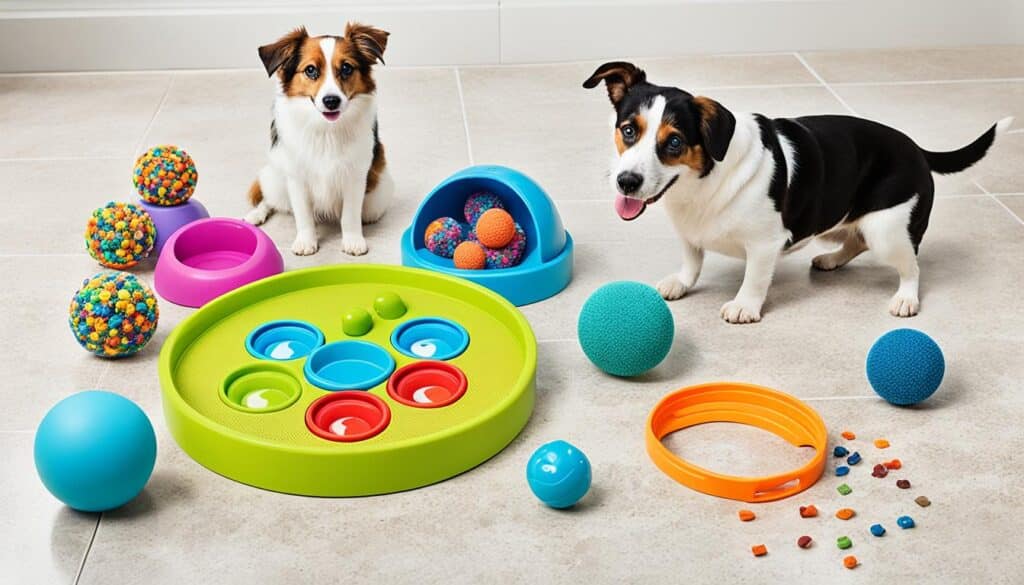Do you ever think about how pets age compared to us? Pets, like humans, show clear signs as they grow older. These signs can include problems moving, dental troubles, and changes in behavior. Knowing these signs can help you care for your pet better and keep them happy.
For aging pets, a well-rounded care approach is crucial. This includes regular vet visits, special diets, and changing their living space. Taking these steps will ease your pet into their senior years with less stress. Experts agree that gentle, attentive care can turn the aging process into a smooth phase of life.
Key Takeaways
- Aging pets show both physical and mental changes, such as decreased mobility and increased anxiety.
- Regular veterinary check-ups are crucial for early detection and management of health issues.
- Adjusting diet and home environment can significantly enhance senior pet comfort.
- Behavioral alterations, like increased irritability, can indicate underlying health conditions.
- Proper care and attention can make the aging process a peaceful journey for pets.
Recognizing Physical Signs of Aging in Pets
As pets get older, they show many physical changes. It’s important to spot these early. This way, you can take better care of your senior pet and help them lead a full life. Here are some signs of aging in pets to watch for.
Slowing Down or Difficulty Moving Around
Older pets may move less and find it hard to get around. This could be because of arthritis or other joint issues. They might have trouble with things like climbing stairs or jumping.
Changes in Weight
Weight changes are a key sign of aging in pets. Seniors might gain weight from less activity, or they could lose weight fast, showing there’s a health issue. If an older dog loses over 10% of their weight in a few months, see a vet.
New Lumps and Bumps
Finding new lumps on your pet is serious. Some might be harmless, but others could be cancerous. It’s vital to get them checked early to handle these signs of aging in pets.
Cloudy Eyes or Vision Issues
Cloudy eyes could mean cataracts or other eye problems from aging. Get your pet’s eyes checked as these issues can get worse. This will help keep your pet’s quality of life high.
Bad Breath or Dental Issues
Overlooked oral health is a big issue in old pets. Their teeth and gums can get bad, causing them to lose teeth and have foul breath. Regular dental care and check-ups can stop many problems.
Knowing these physical signs of aging aids in proper senior pet care. It ensures you can take action in time, enhancing your pet’s life. If you see significant changes, talk to your vet. This is vital for keeping your pet healthy in their elder years.
| Dog Size | Age Considered Senior |
|---|---|
| Small Breeds (e.g., Chihuahuas) | 7 to 12 Years |
| Medium Breeds | 10 Years |
| Large Breeds | 8 Years |
| Giant Breeds (e.g., Great Danes) | 6 to 7 Years |
Understanding Behavioral Changes in Aging Pets
As pets get older, they might start acting differently. It’s crucial to understand these changes. This way, we can make sure they’re happy and healthy. Often, these changes can show us that our pets might have health problems. So, it’s important to pay attention to them.
Sudden Grumpiness or Irritability
Older pets might become more easily annoyed or grumpy. This could be because they’re in pain from things like arthritis. Make sure to watch your pet. If you notice they’re not acting like themselves, it’s time to see a vet. They can help manage any pain your pet might be feeling.
Increased Anxiety or Restlessness
Some aging pets might start feeling more anxious or restless, especially at night. CCDS, a common issue in older dogs, could be the cause. It can make pets seem confused and scared of everyday things. Talk to your vet if your pet is showing these signs.
Incontinence or House Training Problems
Older pets might have accidents indoors or forget their training. This could mean they have a health issue like a urinary tract infection. Treatment often includes medicine or changes to their routine. It’s best to see a vet for an accurate diagnosis and help with a plan to fix the problem.
Recognizing and dealing with these changes can make a big difference in your pet’s life. It helps them be happy and healthy for as long as possible.
The Importance of Regular Veterinary Checkups
Looking after senior pets is very important. Cats are seniors by about 10 years old, while big dogs reach senior status at six. It’s crucial to know what their health needs are. Senior pets need to see the vet at least twice a year. This is more often than younger pets, who usually go once a year.
Regular checkups can catch early signs of health issues. These could be eye problems, joint pains, or kidney trouble. Catching these problems early makes them easier to treat. It’s especially important to check for dental problems. These can cause serious health issues if ignored.
Vets can give great advice on how to keep your older pet healthy. They might suggest changes in diet or a specific exercise plan. These can help older dogs live longer. MedVet offers special care like water therapy and massages for seniors.
Having pet insurance is a big help when your pet is older. It cuts costs for checkups and treatments. This way, money worries won’t keep you from taking your pet to the vet.
Here’s how often different pets should see the vet:
| Pet Type | Age Considered Senior | Recommended Vet Visits |
|---|---|---|
| Cats | 10+ years | Twice per year |
| Small Dog Breeds | 7-9 years | Twice per year |
| Large Dog Breeds | 5-7 years | Twice per year |
Regular checkups keep your pet at their best. Vets use these visits to make sure your pet is doing well. They offer tips for keeping your pet healthy. This means your pet can enjoy their older years more.
Adapting Your Home for Senior Pets
As our pets get older, making their environment more suitable for them is crucial. This change can greatly improve their life. With the right home adjustments, senior pets can feel more comfortable and happier.
Providing Comfortable Bedding
Older pets need special bedding for comfort. Orthopedic or raised beds are great choices. They offer support and help pets with joint pain to sleep better. Memory foam beds shape to their body, providing much-needed comfort.

Adjusting Food and Water Bowls
Using raised feeders can make eating and drinking easier for senior pets. These bowls help improve posture and reduce strain on their neck and joints. Right nutrition and ergonomic bowls are vital for their health.
Slip-Proof Flooring Solutions
Falls can be dangerous, especially for pets with mobility issues. To prevent slips, use non-slip mats or paw coatings. These simple changes can make your home safer and give your pet more freedom.
| Home Adaptation | Benefit | Recommended Product |
|---|---|---|
| Orthopedic Beds | Reduces Joint Pain | Memory Foam Beds |
| Elevated Feeders | Promotes Better Posture | Adjustable Raised Bowls |
| Slip-Proof Mats | Prevents Injuries | Non-Slip Rugs |
Adapting your home for older pets makes them physically and emotionally better. It’s about creating a safe, loving space for them in their senior years.
Nutrition and Diet for Aging Pets
Adjusting a pet’s diet as they grow older is very important. This helps keep them healthy and happy in their senior years. Tackling weight and health problems in older pets, through diet, is key. Older pets might need around 20% fewer calories, especially if they’re less active. This reduction may even reach 30% if they move less.
Managing weight is crucial, as it can affect health problems like arthritis and diabetes. On the flip side, losing weight suddenly might mean there’s an underlying health issue. So, it’s vital to adjust older pets’ diets to deal with these issues. This usually means adding easy-to-digest proteins and cutting calories while keeping the essential nutrients.
It’s also a good idea to think about adding supplements for older pets. Glucosamine can help with joint health, and omega fatty acids can enhance brain function. Since a good portion of older dogs might deal with cognitive issues, brain-boosting supplements can be a big help.
Getting advice from a vet on your pet’s diet is very important. A professional like Wendy Stevens suggests seeing the vet regularly. This helps spot and handle any health problems early. Noticing symptoms like cloudy eyes or unusual bumps can mean getting help quickly.
Watch for behavior changes like anxiety or memory loss. These could signal that diet changes are needed.
In essence, good nutrition that’s well-aligned with your pet’s age, backed by vet advice, is a game-changer for older pets.
| Pet Type | Age Considered Senior | Key Dietary Adjustments |
|---|---|---|
| Great Danes | 6 years | Reduce calories by 20%, incorporate joint supplements |
| Chihuahuas | 7-10 years | Manage weight, monitor for metabolic disorders |
| General (Dogs over 8 years) | 8 years | Consider supplements for cognitive health, regular checkups |
Maintaining Mental Stimulation
Keeping senior pets mentally active is key for their brain health as they age. Just like people, pets need to exercise their minds, not just their bodies. Engaging them with fun activities can stave off boredom and slow down cognitive decline.

Puzzle Toys and Interactive Games
Interactive toys, such as puzzle feeders and treat games, are great for older pets. They make your pet think and problem solve, which is good for their mind. At J&J Dog Supplies, there’s a range of toys that are perfect for older dogs, mixing fun with a mental workout.
New Training and Obedience Commands
Teaching new tricks and refreshing old commands keeps your pet’s brain in shape. It’s a great way to keep them interested and their minds active. This helps your pet feel happy and connected to you, their owner, as they age.
| Activity | Benefit |
|---|---|
| Puzzle Toys | Enhances problem-solving skills |
| Interactive Games | Prevents boredom and anxiety |
| New Commands | Maintains obedience and mental agility |
Gentle and Appropriate Exercise Routines
Exercise is key for the health of older pets. It should be gentle to fit their physical needs. A routine with easy activities keeps their muscles and joints in shape. It must also be safe for their health.
Low-Impact Activities
Older pets benefit greatly from easy exercises. Things like slow walks or light play help. They keep pets healthy and reduce injuries. Walking is great for aging dogs. It makes for a happy and healthy pet. Lateral walking helps prevent some injuries too.
Swimming for Joint Health
In general, swimming is top-notch for older pets, particularly dogs. It’s in water, so it’s easy on the joints. Plus, it gets the heart and lungs working well. Swimming builds stronger joints without being hard on the body.
Make a custom exercise plan for your aging pet. Your vet can help make sure it’s right for them. Some dogs love to swim, but not all are suited to it. Focus on easy and safe exercises. Add swimming for even more benefits. This way, senior pets stay lively and healthy.
| Breed Group | Age Considered Senior | Recommended Exercises |
|---|---|---|
| Small Breeds (e.g., Chihuahua) | 7-10 years | Leisurely walks, light play |
| Medium-Sized Breeds | 8-10 years | Lateral walking, swimming |
| Large Breeds (e.g., Great Dane) | 6 years | Gentle hikes, low-impact play |
10 Signs Your Pet is Aging and How to Help Them
Aging is part of life for pets too, requiring extra care. Knowing the signs of aging is key to help them. For example, big dogs like Great Danes are seniors at about six years old. On the flip side, small dogs might not look or act old until they’re seven or more. Cats hit senior status at ten years.
One big clue of age in pets is how they move. Arthritis and other health problems can slow them down. You might see stiffness, less interest in doing their usual activities, or even limping. Both dogs and cats may not see or hear as well as before, affecting how they react. Just like aging people, pets might get cloudy eyes or muffled hearing.
Older pets might also act differently. 14% to 35% of dogs past eight might get Canine Cognitive Dysfunction Syndrome. They could act confused, anxious, or grumpy. Likewise, elderly cats might become more moody or change how they behave. It’s crucial to keep their brains and bodies active with fun and challenging activities.
Changes to their weight are a red flag. Dogs gaining weight might struggle to move and start feeling joint pain. On the other hand, senior cats losing weight could point to serious health issues. Just like us, both groups often face dental problems as they age. To catch and prevent these issues, regular trips to the vet are essential.
Senior pet care can get expensive, but there’s help available. Adapting your pet’s diet, exercise, and living conditions can make a big difference. With the right care, your elderly pet can still find joy in life.
